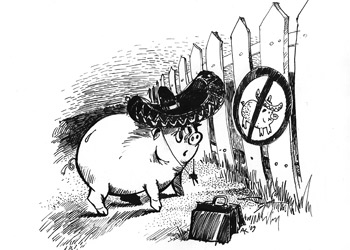When Pigs Sneeze
A great man once said, “The speed of communications is wondrous to behold. It is also true that speed can multiply the distribution of information that we know to be untrue.”
It is not without a feeling of sadness that I cite the late Edward R. Murrow, a man whose presence in this increasingly media saturated world many could have benefited from in recent weeks.
Murrow, as immortalized in celluloid by David Straithairn in Good Night, and Good Luck was, in essence, the living embodiment of an honest and ethical journalist; driven by a burning desire to right many wrongs, report the truth, and who undoubtedly would have observed the media’s descent into their swine-induced sensationalist madness with astonishment.
As the unnatural hysteria that filtered through the Polish media over the spread of the A (H1N1) influenza virus was absorbed, I wondered what Murrow would’ve thought about the future of news gathering and where journalism was heading.
Maybe the furious scramble to broadcast and report breaking news has slowly taken its toll. Indeed, it seems that the very soul of the industry has been ripped to shreds by an uncompromising quest for ratings. But at what cost?
It was dubbed “The Week The World Held Its Breath,” but most found it impossible to breathe altogether. Constant reminders of a rampaging virus striking down all in its path appeared across the country. The tabloids screamed catastrophe, and warned of impending doom, when a simple check on the World Health Organization’s website (or “research,” as it is known) would have calmed the nerves of millions. Unfortunately, in the eyes of editorial staff, such information would not provide the desired website hits, or sell the appropriate number of newspapers.
Of course, the spread and the potency of the virus should not be dismissed. At time of press, the WHO recorded 11,034 official worldwide cases and 85 deaths as a result of the A (H1N1) virus, so to trivialize the danger is irresponsible and disrespectful to those who suffered at its hands. However, a dose of context is needed amongst the insanity. The Spanish flu of 1918 killed – in a European continent dying of hunger and riddled with disease following the Great War – 40-50 million people. The 1957 Asian Flu killed around one million, and in 1968 the Hong Kong Flu caused approximately 700,000 deaths. Last year, 5,437 people died as a result of accidents on Poland’s roads. Poles would be better inclined to look both ways when crossing the street than worry about being struck down by the rogue virus.
Professor Andrzej Zieliński, from the Polish National Institute of Hygiene, believes, as do many other doctors and specialists around the world, that the disease is less contagious than the seasonal flu, and that the mortality rate is not alarming compared to other illnesses. The statistics appear to be in Zieliński’s favour: in Poland during 2007, seasonal influenza infected 374,042 people. As KP rolled press, the A (H1N1) virus had been treated in four Polish nationals.
Experts speculate that a vaccine is three to six months away, but it may transpire that it will never be used en masse. As Dr. Margaret Chan, director-general of the WHO said, “The world is better prepared for an influenza pandemic than at any time in history, thanks, in part, to your vigilance and diligence.”
The world’s media would be wise to heed her words, and stop trying to force more action than is needed. The more the public are subjected to media cries of “wolf,” the more inclined they will be to dismiss news if something sinister does finally appear.

